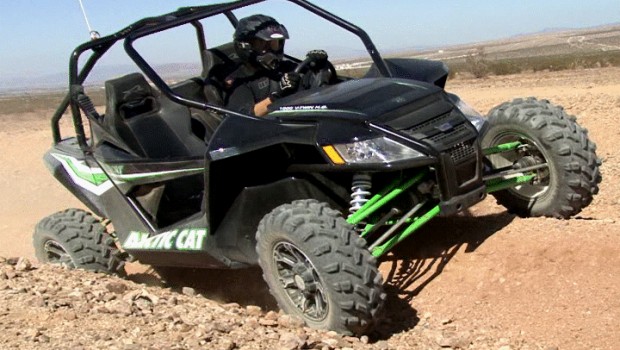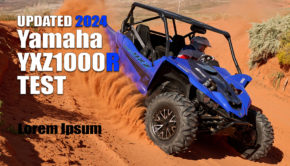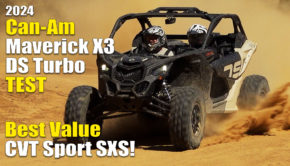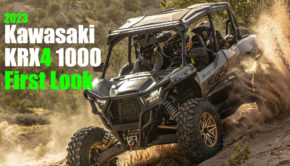2012 Arctic Cat Wildcat 1000 Test: With Video
 Since the launch of the first Yamaha Rhino back in 2003, side-by-sides have evolved from low-speed utility machines into much faster and higher performance sport utility vehicles. For the past few years, Polaris has been the only manufacturer offering true sport specific side-by-sides, with their line of RZRs. We knew it would only be a matter of time until their high performance supremacy was challenged, and that time has come in a big way!
Since the launch of the first Yamaha Rhino back in 2003, side-by-sides have evolved from low-speed utility machines into much faster and higher performance sport utility vehicles. For the past few years, Polaris has been the only manufacturer offering true sport specific side-by-sides, with their line of RZRs. We knew it would only be a matter of time until their high performance supremacy was challenged, and that time has come in a big way!
Over the past few years, Arctic Cat has been developing a machine with which to dominate the side-by-side world––a machine with more displacement, longer suspension, travel, and more features than the competition. The new Wild Cat 1000 abandons the usual truck-like appearance of most other side-by-sides for a distinctively dune buggy-like appearance.
Make no bones about it, the Wild Cat takes aim directly at the Polaris RZR XP900. On paper, the Wild Cat appears to have some distinct advantages. To prove them to us, Arctic Cat invited us to the desert just outside Barstow, California–– a popular practice area for desert truck and buggy racers. The terrain offers lots of high-speed sections, deep-rutted whoops, and the occasional gnarly rock bed. This terrain is a lot of fun for drivers, but it is hell on an off-road vehicle. It is the perfect location to put the Wild Cat to the test.
The Cat is powered by the same 951cc power plant used first in the Thunder Cat, now 1000 GT ATV, and was later used in Arctic Cat’s Prowler 1000 side-by-side. The V-Twin engine features 4 valves and single overhead cams per cylinder. Fuel is injected into the cylinders via 50mm throttle bodies. New intake and exhaust systems were developed specifically for use in the Wild Cat to further increase performance.
The CVT Transmission features high and low ranges plus neutral and reverse. There’s selectable two- and four-wheel drive with available differential lock. The drive train features Arctic Cat’s Spike Load Damper. It’s a clutch that allows a tiny amount of slippage for thousandths of a second, reducing extreme jolts to the drive train, like when landing from a jump at full throttle.
The transmission shifts easily into gear; however, we wish there was some kind of locking mechanism for the shifter to keep it in place. With a push of the gas pedal, the vehicle gets rolling with a quiet, authoritative roar. There is ample power, as you would expect with this much displacement. Power starts off low and builds seamlessly throughout the RPM range. The Wild Cat could best be described as muscle car-like–– unstoppable, yet taking some time to build RPMs.
The Wild Cat is fast, yet very manageable, making it ideal for long drives. Ripping across smooth sections of the desert floor, we hit speeds just over 65mph. The Wild Cat accelerates well out of corners and through deep sand. We just wish it had a bit more snap, for a little quicker acceleration and better weight transfer control while attacking jumps. It’s an awesome cruiser that should have serious race potential.
The chassis is constructed from high-strength, low-alloy, tubular steel. It features a full-perimeter exoskeleton type design, similar to what’s being used in desert race trucks. Dual A-arm front suspension and Arctic Cat’s five-point, multi-link, rear suspension feature class leading travel, with 17-inches up front and 18-inches out back, beating their closest competitor by four inches at both ends! The suspension features Arctic Cat’s, “ride in” design, to help keep the center of gravity down and the wheels tracking with the ground. The 5-point rear suspension was designed to keep the rear wheel traveling vertically throughout the suspension travel, keeping the center contact patch of the tire in contact with the ground for better suspension action and improved traction.
Walker Evans Racing shocks control suspension action at both ends. The reservoir-equipped shocks feature 17 position compression damping adjustment, in addition to threaded preload and crossover adjusters.
For the desert in which we tested, the Wild Cat handles phenomenally. No other side-by-side on the market drives straighter, or eats three-feet deep whoops at the speeds of the Wild Cat 1000! Big horsepower and a 40/60 front and rear weight balance keep the machine flying level through rough sections or over jumps.

No other side-by-side on the market drives straighter, or eats three-feet deep whoops at the speeds of the Wild Cat 1000!
A 95-inch wheelbase is closer in length to four-seater models than it is to other two-seated sport side-by-sides. This definitely helps the Wild Cat in straight lines, but it gives the big cat a wider turning radius, which could make tight sections more difficult back East.
It corners pretty predictably, especially with two occupants. We did notice some body roll that we were able to reduce with some suspension adjustment. It was fun to slide the Wild Cat around on the flats; however, we felt it worked best driving through the turns hooked up.
Bump steer and bump feedback were virtually non-existent, thanks to the Cat’s electric power steering, which makes steering the 1000 easy. Arctic Cat did a good job of allowing just enough trail feedback to keep you feeling connected to the terrain.
Suspension action on the Wild Cat was flat out incredible! While its action seemed plush enough at slower speeds, we didn’t spend enough time there to tell you for sure. Stock settings were a bit soft on the rear shocks, creating body roll and allowing the machine to frame out too often in the deep-rutted whoops. To cure this, the Arctic Cat representatives changed the crossover setting to get the rear shocks on the firmer main spring sooner, keeping them riding higher in the travel. After a few test loops, we finally had the compression clicker maxed out. The end result was an amazingly smooth ride through mega-huge, rutted whoops, pounded into existence by decades of desert truck practice. Dialed in the suspension’s action was nearly perfectly balanced. The front shocks felt virtually flawless from the beginning. For more moderate paces or driving environments, the shocks offer plenty of adjustment to soften things up if needed.
Hydraulic disc brakes at both ends offer good stopping power and provide decent feel through the pedal. Our only complaints about the brakes were the occasional noise, and they sometimes bound up just a bit after extreme braking.

Despite being a sport machine, the Wild Cat’s cockpit is perhaps the most comfortable of any side-by-side.
Despite being a sport machine, the Wild Cat’s cockpit is perhaps the most comfortable of any side-by-side. The contoured high-back seats feature cut and sewn covers and offer plenty of padding. Their wrap-around design helps hold you in place, making you feel one with the machine. The seats are mounted five-inches lower than those in the RZR XP adding to the car-like feel of the Wild Cat and reducing the amount of movement transferred to the occupants as the machine traverses rough terrain. Arctic Cat’s anti-cinch seat belts never seemed to dig into our collarbones like most other three-point restraints do. While we were disappointed by the lack of a front passenger grab bar, the ride was so smooth you could merely hold onto the door handle and leave your left hand in your lap. Other cockpit amenities include drink holders, glove box, power outlet, plus combo digital and analog instruments.
As a pure sport side-by-side, the Wild Cat is without a hitch, but has 300 pounds of cargo-carrying capacity in its bed. The machine is available in both Arctic Cat green or black and features a metal flake, automotive paint finish. It looks sweet and is tougher than normal plastic, but it will cost more to replace in the event of a rollover. LED head and taillights are a nice touch, along with the gorgeous 14-inch aluminum wheels.
Conclusion
With a retail price of $16,599, features like EPS, painted plastic, plus class-leading suspension travel are stacked in the Wild Cat’s favor. Its superb real-world performance makes us crave owning one. While it’s not completely perfect, there are things it does notably better than any of its competitors, like going ridiculously fast in the rough, and doing so while cocooning both driver and passenger in complete comfort. Arctic Cat may have just changed the way people perceive side-by-side performance, and them as a company.
Specifications
-
-
COLOR
- Arctic Green Metallic Paint, Black Metallic Paint
-
ENGINE
-
| Displacement | 951 | |
| Engine Type | V-Twin SOHC 4-stroke, 4-valve w/EFI HO | |
| Bore & Stroke | 92×71.6 | |
| Cooling System | Liquid with twin fan | |
| Fuel Capacity | 8.8 gal. / 33.3 liters | |
| Alternator Capacity |
36 amps | |
| Speedometer | Analog | |
| Odometer | Digital |
-
-
POWERTRAIN
-
| Transmission | Automatic CVT with EBS, Hi/Lo Range & Reverse | |
| Drive System | 2/4 WD + Electric Diff Lock | |
| Front Brakes | Hydraulic Disc | |
| Rear Service Brakes |
Hydraulic Disc |
-
-
SUSPENSION
-
| Front Suspension | Double A-Arm | |
| Front Travel | 17 in. / 43.2 cm | |
| Rear Suspension | 5-Link Trailing Arm | |
| Rear Travel | 18 in. / 45.7 cm | |
| Front Tires | 26 x 9-R14 | |
| Rear Tires | 26 x 11-R14 |
-
-
DIMENSIONS
-
| Overall Length | 120 in. / 304.8 cm | |
| Overall Width | 64 in. / 162.6 cm | |
| Overall Height | 65.8 in. / 167 cm | |
| Wheelbase | 95 in. / 228.6 cm | |
| Ground Clearance | 13 in. / 33.0 cm | |
| Dry Weight | 1305 lb. / 592 kg |
-
-
TOWING/HAULING
-
| Front Rack Capacity | NA | |
| Rear Rack Capacity | 300 lb. / 136.1 kg | |
| Towing Capacity | NA |
-
SPECIAL FEATURES
- Electronic Power Steering, Aluminum Rims, Paint, Tilt Steering, Compression Valve Adjustable Shocks, LED Headlights and Taillights
2012 Arctic Cat Wildcat 1000
Summary: With a retail price of $16,599, features like EPS, painted plastic, plus class-leading suspension travel are stacked in the Wild Cat’s favor. Its superb real-world performance makes us crave owning one. While it’s not completely perfect, there are things it does notably better than any of its competitors, like going ridiculously fast in the rough, and doing so while cocooning both driver and passenger in complete comfort. Arctic Cat may have just changed the way people perceive side-by-side performance, and them as a company.












